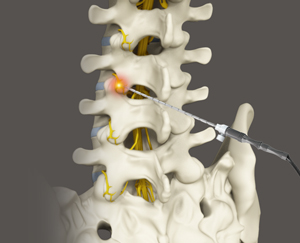
What is Radiofrequency Lesioning (RFL)?
Radiofrequency lesioning (RFL) is a minimally invasive surgical procedure employed in the management of chronic, debilitating pain by interrupting nerve conduction. This procedure is performed to treat painful facet joints in the spine that usually cause chronic lower back and neck pain. The procedure uses high-frequency radio waves to heat electrodes which contact the specific nerve causing the problem until a lesion is created at the contact point. These lesions block the nerve from transferring the pain signal to the brain.
Indications for Radiofrequency Lesioning (RFL)
Most patients with chronic neck (cervical spine) and lower back (lumbar spine) pain arising from the facet joints can be assisted with a combination of physical therapy, medication, and selective spinal injections. However, some patients report persistent pain despite the use of these measures. Radiofrequency lesioning is indicated in circumstances where the patient has failed to respond to other therapeutic measures. Some conditions that radiofrequency lesioning can alleviate include the following:
- Trigeminal neuralgia
- Brachial plexus avulsions
- Occipital nerve neuralgia
- Post-herpetic neuralgia
- Pain resulting from spinal cord injury
- Coccydynia (tailbone pain)
- Persistent neck and back pain
- Spinal arthritis and stenosis
- Peripheral neuropathy
- Complex Regional Pain Syndrome (CRPS)
Preparation for Radiofrequency Lesioning (RFL)
Preparation for radiofrequency lesioning involves the following steps:
- A thorough examination by your doctor is performed to check for any medical issues that need to be addressed prior to the procedure.
- Depending on your medical history, social history, and age, you may need to undergo tests such as blood work and imaging to help detect any abnormalities that could threaten the safety of the procedure.
- You should inform your doctor of any medications, vitamins, or supplements that you are taking.
- Inform your doctor if you are allergic to any specific medications.
- You should refrain from medications or supplements such as blood thinners, aspirin, or anti-inflammatory medicines for 1 to 2 weeks prior to the procedure.
- Refrain from eating or drinking anything after midnight the night before your procedure.
- Arrange for someone to drive you home as you will not be able to drive yourself after the procedure.
- A written consent will be obtained from you after the procedure has been explained in detail.
Procedure for Radiofrequency Lesioning (RFL)
Radiofrequency lesioning is typically performed as an outpatient procedure under local anesthesia and takes about 30 to 60 minutes. In general, the procedure involves the following steps:
- You will be placed on the table in a face-down position to provide the best access to your cervical or lumbar spine region.
- A local anesthetic is used to numb the treatment area. Sometimes a mild sedative may also be administered to help you relax during the procedure.
- The procedure is performed under the guidance of fluoroscopy. The fluoroscope is a special kind of X-ray machine that helps doctors visualize the placement of the needle electrode when inserted.
- During the procedure, your doctor will direct a special radiofrequency needle electrode close to the facet joint so that that the needle tip lies close to the medial branch nerve.
- Medial branch nerves are very small nerves that innervate or supply the facet joints of the spine. Facet joints are the joints connecting each vertebra of the spine to each other. These joints are present on both sides of the spine from the neck down to the lower back.
- Once the needle and electrode placement is verified by fluoroscopy, a small pulse of radiofrequency energy is sent through the needle to create a tiny burn or lesion.
- These pulses heat the nerve to approximately 80 degrees Celsius for about 2 to 3 minutes to damage the nerve, thus preventing pain signals from traveling to the brain.
- The needle is removed, and the injection site is covered with a dry, sterile bandage.
Recovery
Following radiofrequency lesioning, you should be able to go home within a couple of hours. You may resume your normal diet. Do not drive or perform vigorous physical activity for 24 hours after the procedure. If pain increases, pain medication may be prescribed to keep you comfortable. If you notice swelling and redness at the injection site, apply ice over a towel for 20 minutes every hour to the area to ease the discomfort. Although the results of radiofrequency lesioning vary, the pain relief achieved typically lasts from 6 to 12 months in most patients. A follow-up appointment will be scheduled to monitor your progress.
Risks and Complications
Radiofrequency lesioning is a relatively safe procedure; however, as with any procedure, some risks and complications may occur, such as the following:
- Infection
- Soreness
- Nerve injury
- Pain and tenderness
- Allergic reactions
- Neuritis (inflammation of the nerves)
